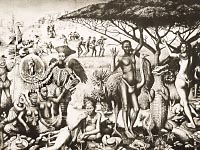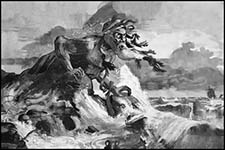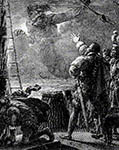ADAMASTOR
ref. # 132 (reverse #029) -´Os Lusíadas´
 Cyril COETZEE, 'T'kama-Adamastor'. Oil on canvas, (1999), 8,64 x 3,26 meters. William Cullen library, Universi, of the Witwatersrand, Johannesburg
Cyril COETZEE, 'T'kama-Adamastor'. Oil on canvas, (1999), 8,64 x 3,26 meters. William Cullen library, Universi, of the Witwatersrand, Johannesburg'Os Lusíadas', usually translated as 'The Lusiads', is a Portuguese epic poem by Luís Vaz de CAMÕES.
Written in Homeric fashion, the poem focuses mainly on a fantastical interpretation of the Portuguese voyages of discovery during the 15th and 16th centuries. Os Lusìadas is often regarded as Portugal's national epic, much in the way as Virgil´s Aeneid was for the Ancient Romans, as well as Homer's Iliad and Odyssey for the Ancient Greeks. It was first printed in 1572, three years after the author returned from the Indies. (Wikipedia)
´Os LusÍdias´, by Luís de CAMÕES Project Gutenberg
©: painting Cyril Coetzee
tags: #Cyril Coetzee #Os Lusiadas #Adamastor
- CLICK ON THE SMALL PICTURES TO SEE AN ENLARGED VERSION -
Adamastor Unbound? | 27
"The story of Adamastor, claimed both as the origin of European-style literature and of literary criticism in South Africa, has been told and retold in a number of forms since Luís de Camões’s 1572 epic poem Os Lusìadas (see Gray 1977). As the Portuguese explorer Vasco da Gama and his crew approach the Cape of Storms, they are filled with terror at a form emerging from darkness. A mysterious giant emerges in the rocky cape, cursing the imperialistic hubris of the Portuguese who dare to violate his realm
(Graham 2012: 19). The ships will be wrecked, he warns, and catastrophe will befall those who reach land. Undeterred, da Gama commands the giant to identify himself. The giant explains that he is Adamastor, a Titan who loved and tried to ravish the sea nymph Tethys. As she escaped, she laughingly drew attention to his hugeness, which made their union impossible. Tethys and her mother lured Adamastor to a trysting point, where he embraced a decoy, falling under a spell that gradually turned him to rock. Adamastor became the massive form of Table Mountain, while Tethys herself was transformed into the waves, lapping tantalizingly and eternally around the giant’s form."
"Coetzee himself explains in his essay that he has tried to “make ironic and fantastic use of a variety of tropes and clichés of the colonial world-view” (C. Coetzee 2000: 3–4). This idea of “new ways of looking” that are “ironic and fantastic” is echoed in the volume’s subtitle, “Inventions of Africa in a South African Painting.”
This open access edition (search for: Chapter_1_Adamastor_Unbound_Whiteness_and_Landscap.pdf) has been made available under a CC BY-NC-ND 4.0 license
thanks to the support of Knowledge Unlatched. https://doi.org/10.3167/9781800736627.
Coetzee positions the painting as a metaphorical response, from the perspective of an (unnamed) Indigenous African people, to two other paintings that hang in the library—Colonists 1826 by Colin Gill (1934) and Vasco da Gama: Departure for the Cape by J. H. Amshewitz (1935) (C. Coetzee 2000: 5–9)
All texts: doi.org/10.3167/9781800736627.
tags: #adamastor #C. Coetzee #Colin Gill #H.Amshewitz #Vasco da Gama
See also:
Hanzimanolis, Margaret, Southern African Contact Narratives: 'The Case of T’Kama Adamastor and its Reconstructive Project', Kunapipi, 24(1), 2002. Available at: https://ro.uow.edu.au/kunapipi/vol24/iss1/21
129 - 'Adamastor'
 'Azulejo' (glazed tiles) on a terrasse of the Palace Hotel de Buçaco
'Azulejo' (glazed tiles) on a terrasse of the Palace Hotel de Buçaco©: PD Wikpedia by 'Concierge.2C'
tags: #adamastor
ref. # 129a - Adamastor
 Five days after the stop in the Bay of St. Helena, comes Vasco da Gama at Cape of Storms and is surprised by a dark cloud "so fearful and charged" to put in the Portuguese hearts a big "fear" and takes Vasco da Gama to evoke the very Almighty God.
Five days after the stop in the Bay of St. Helena, comes Vasco da Gama at Cape of Storms and is surprised by a dark cloud "so fearful and charged" to put in the Portuguese hearts a big "fear" and takes Vasco da Gama to evoke the very Almighty God.It was the appearance of the giant Adamastor, a mythological figure created by Camões to mean all the dangers, storms, shipwrecks and "Damnations of all sorts" that the Portuguese had to face and overcome in their journeys. ©: unknown; more info here: oslusiadas.no.sapo.pt
'Os Lusíadas', poema epico . Nova edição correcta, e dada á luz, por Dom Ioze Maria de Souza-Botelho.
CAMÕES, Luís [Vaz] de.
Published by Paris, Officina Typographica de Firmin DIDOT, (1817) From: Richard C. Ramer Old and Rare Books (New York, NY, U.S.A.) est. US$ 15,000.00
LIGNON engraved the frontispiece portrait of Cam&otile;es after a design by Gérard, while Forsell (after Dessenne) engraved Camões in the gruta named for him in Macau. The remaining 10 plates were engraved by Massard, Oortman, Henri Laurent, Bovinet, Pigeot, Toschi, Forster, and Richomme after designs by DESSENNE (3) and FRAGONARD (7 -including apparently this gravure)
Aparição do Gigante Adamastor (Canto V, 49).
Gravura de Fragonard para a edição de Os Lu, iacute;adas d, Morgado, e Mateus.
tags: #Adamastor #Os Luciadas #Camoes #Vasco da Gama



